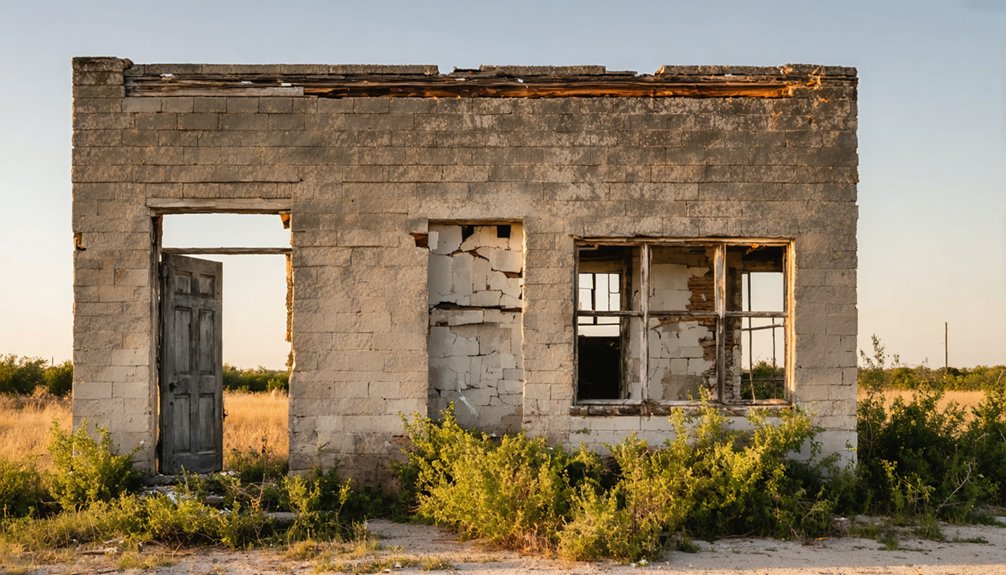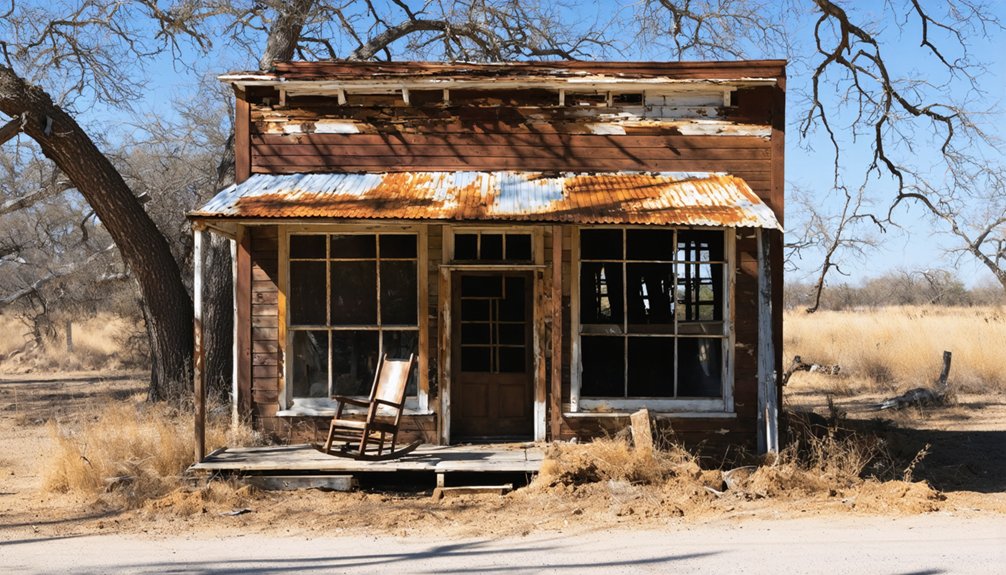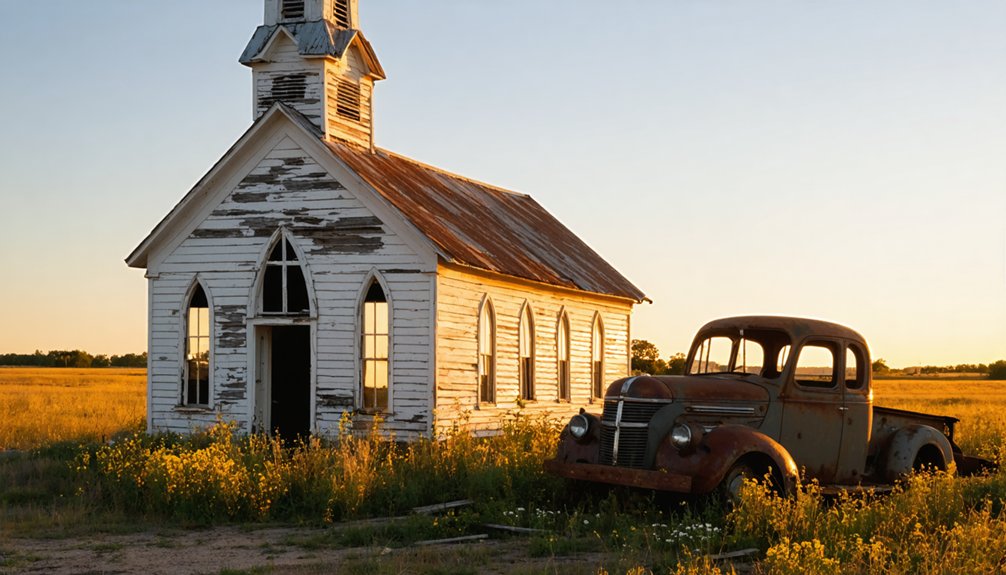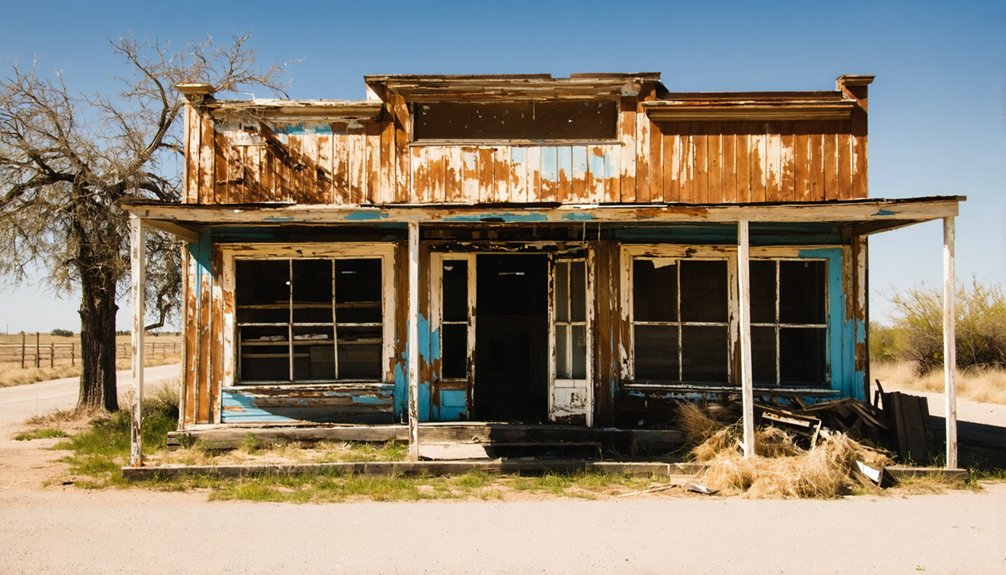You’ll discover Holt’s dramatic story as an oil boomtown established in 1903 that flourished through the 1910s and 1920s. The town supported thousands of residents with its thriving oil fields, coal mines, and railroad operations. By the 1930s, economic shifts and the Great Depression triggered its decline, leading to complete abandonment by the 1950s. Today, Holt’s ruins and ghostly legends offer fascinating glimpses into Texas’s boom-and-bust heritage.
Key Takeaways
- Founded in 1903, Holt flourished during the 1910s oil boom before declining through the Great Depression and becoming abandoned by the 1950s.
- The town’s economy relied heavily on oil production, coal mining, and railroad operations, producing up to 2,000 tons of coal daily.
- During its peak, Holt supported thousands of residents with basic amenities, general stores, churches, and dance halls.
- A 148-foot smokestack remains as a testament to Holt’s industrial heritage and coal mining operations.
- The town’s abandonment followed mine closures in the 1940s, leading to mass exodus and local folklore about ghost miners.
A Brief Timeline of Holt’s Rise and Fall
While many Texas ghost towns faded quietly into history, Holt’s story spans just over five decades of dramatic transformation from its founding in 1903 to its eventual abandonment in the 1950s.
You’ll find that Holt’s early years showed promising community growth, with the establishment of schools, churches, and local businesses supporting a vibrant population. Like many of the 511 ghost towns across Texas, it held dreams of lasting prosperity.
The 1910s marked the town’s peak, as educational institutions expanded and commerce flourished. By the 1930s, the town featured a thriving church and sawmill alongside scattered farms.
However, economic shifts in the late 1920s began to erode this prosperity. The Great Depression dealt a severe blow, triggering a chain of closures and outmigration.
Holt’s downfall began in the 1920s, with economic turmoil and the Great Depression forcing businesses to shutter and residents to flee.
By the 1940s, Holt’s decline accelerated as transport routes favored other areas.
The final chapter closed in the 1950s, when the last residents departed, leaving only scattered ruins to mark this once-thriving community’s existence.
The Economic Engine That Built Holt
The economic pulse of Holt, Texas stemmed primarily from its rich oil discoveries in the early 1900s, setting the stage for a classic boom-and-bust cycle that would define the town’s existence.
You’d have seen drilling operations attracting workers, while supporting industries like railroads and services quickly followed suit. Similar to Richwoods’ dependency on tip mills, Holt’s economic stability relied heavily on its primary industry.
The town’s economic cycles weren’t solely tied to oil dependency. Railroad access proved essential for shipping goods, while agriculture and natural resources like timber provided additional revenue streams.
Like many towns facing economic downturns and disasters, the decline of Holt’s industries led to its eventual abandonment. When wells began to dry up, Holt’s fate mirrored many Texas boomtowns. The Dust Bowl‘s impact on farming, combined with mechanization reducing labor needs, further weakened the local economy.
As larger oil fields elsewhere drew investment away, Holt’s diverse but resource-dependent industries couldn’t sustain its population, leading to its eventual ghost town status.
Life in Holt During Its Peak Years
During its peak years in the early-to-mid 20th century, Holt buzzed with the energy of hundreds, possibly thousands of residents drawn to its promising oil fields.
You’d find workers’ families living in simple wood-frame houses along dirt streets, while basic services like water and electricity kept the town running. Life centered around local establishments – general stores, taverns, and small churches where community gatherings offered relief from the demanding oil field work. The town saw frequent thefts that led to the post office manager sleeping with cash to protect it overnight. Like many of the over 500 ghost towns across Texas, Holt’s fate was sealed by economic changes.
Yet, you’d also encounter typical boomtown social challenges. The town’s jail testified to ongoing struggles with lawlessness, while overcrowding strained limited public services.
Workers faced dangerous conditions without modern safety regulations, and the town’s fortunes rose and fell with oil prices.
Still, residents forged bonds through social events at dance halls and local celebrations.
Natural Resources and Industrial Heritage
You’ll find that Holt’s mining operations followed a pattern similar to nearby Thurber, with coal extraction driving the town’s early growth in the early 1900s and clay being used for local brick production.
The town’s natural resource extraction peaked during the period when coal powered the region’s locomotives and industrial facilities, supported by essential infrastructure like water treatment plants. Just as in Thurber, the company store system required miners to use special currency for all their purchases. Like Thurber’s distinctive red brick buildings, many of Holt’s original structures remain as silent witnesses to its industrial past.
When oil replaced coal as the preferred fuel for transportation, Holt experienced rapid economic decline, leading to resource depletion and eventual abandonment within just 15 years.
Mining Operations Timeline
Mining operations in Holt, Texas emerged during the late 1800s as part of a broader regional coal industry that flourished across Palo Pinto and Erath Counties.
You’ll find that early mining techniques focused on underground extraction through vertical shafts and sloped adits, with both small family operations and larger companies like the Strawn Coal Company working the area’s bituminous coal deposits. During this era, the region saw significant silver mining activity develop alongside coal operations. The region’s success caught the attention of the newly formed Caterpillar company in 1925, which supplied essential machinery to local mining operations.
Labor conditions in the region’s peak years saw 1,000-1,500 miners working daily in underground mines, producing up to 2,000 tons of coal per day.
The introduction of Holt’s track-type tractor in 1904 revolutionized mining operations, though you’ll notice the industry’s decline began in the 1930s as oil gained dominance.
Resource Depletion Effects
As natural resources began to dwindle in Holt and surrounding areas, the once-thriving community faced dramatic shifts in its sustainability and economic viability. Poor resource management led to the rapid depletion of essential minerals, undermining the town’s industrial base and threatening community resilience.
You’ll find that like many Texas ghost towns, Holt’s fate was inextricably linked to its extractive economy.
When the mines could no longer sustain operations, the ripple effects touched every aspect of local life. The industrial infrastructure – from rail depots to processing facilities – fell into disrepair as businesses shuttered and residents relocated.
Environmental impacts compounded these challenges, with abandoned sites contributing to ecosystem changes and leaving behind a legacy of altered landscapes that you can still observe today.
The Architectural Legacy Left Behind

When you visit Holt today, you’ll find weathered home foundations that reveal the careful construction methods of immigrant craftsmen, particularly in the detailed brickwork laid by Polish and Italian masons in the early 1900s.
The most striking remnants are the industrial foundations, including the 148-foot smokestack that towers as a monument to the town’s coal mining heritage. While many structures have crumbled, the surviving architectural elements showcase the blend of European masonry techniques with American industrial practicality, evident in the robust brick walls and iron-fenced boundaries that still define the ghost town’s layout.
Abandoned Home Construction Methods
The abandoned homes of Holt, Texas showcase distinct architectural methods that defined early frontier construction in rural Texas.
You’ll find ghost town architecture that relied heavily on local materials, with frames built from nearby timber and foundations crafted from native stone. The construction methods reveal the resourcefulness of early settlers, who employed balloon framing for quick builds and post-and-beam techniques for sturdier structures.
When you explore these ruins, you’ll notice the characteristic features of rural construction: hand-hewn beams joined with mortise-and-tenon connections, spacious porches supported by wooden columns, and simple gable roofs.
While time has taken its toll, with collapsed roofs and deteriorating walls, the remaining structures still display the craftsmanship and practical adaptations that helped settlers thrive in the Texas frontier.
Industrial Building Foundations Remain
Throughout Holt’s industrial district, surviving foundations tell a compelling story of the town’s economic heritage, with concrete slabs and masonry footings marking the sites of bustling sawmills and lumber facilities.
You’ll find these architectural remnants scattered across the landscape, where sturdy Thurber paving bricks and heavy timber post bases reveal the robust construction methods of the era.
The industrial heritage is preserved in partially standing chimneys and distinctive foundation shapes that once supported ice plants, coal processing facilities, and brick manufacturing operations.
You can trace the evolution of construction techniques through these remains, from early timber-frame structures to more advanced masonry and concrete designs.
The foundations serve as silent witnesses to the technological advancement and economic significance that once defined this Texas industrial town.
Notable Characters and Local Legends
Life in Holt revolved around a cast of colorful characters who shaped the town’s wild reputation and enduring folklore. The town’s streets witnessed legendary figures from all walks – from cunning entrepreneurs running the mines to questionable doctors who vanished without a trace.
You’ll find tales of ghostly encounters with former miners still echoing through the abandoned properties. The company store owners wielded tremendous power through their scrip system, while lawmen struggled to maintain order amid frequent violence and mayhem.
Labor organizers faced fierce opposition from armed company guards, and the town jail – now just ruins – stands as a stark reminder of Holt’s lawless past. Even today, stories persist of hidden treasures, mysterious deaths, and haunted buildings that paint a vivid picture of this turbulent chapter in Texas history.
The Path to Abandonment

While Holt’s colorful characters and legends painted a vibrant portrait of its heyday, economic forces would ultimately seal the town’s fate.
The collapse of Holt’s economic sustainability followed a predictable pattern that crushed the community’s resilience:
Economic decline follows familiar steps: a domino effect that systematically dismantles a community’s foundation until collapse becomes inevitable.
- The mines that once fueled the town’s prosperity dried up in the 1940s, triggering massive layoffs and an exodus of workers and their families.
- Railroad operations diminished and rerouted, severing Holt’s crucial transportation arteries.
- Young residents fled to urban areas seeking better opportunities, while elderly citizens followed for healthcare access.
- Essential services disappeared one by one – schools closed, businesses shuttered, and infrastructure crumbled.
Without its economic backbone and isolated from major transportation routes, Holt couldn’t maintain the critical mass needed for survival, leading to its eventual abandonment.
Visiting the Ruins Today
Modern-day visitors to Holt’s ruins face a challenging but rewarding expedition into Texas’s forgotten past. You’ll need a high-clearance vehicle to navigate the unpaved roads, and you’ll want to bring offline maps since cell service is unreliable.
This ghost town exploration reveals weathered foundations, stone chimneys, and partial walls scattered across the rugged landscape.
For your rural adventure, pack plenty of water and wear sturdy boots to safely traverse the uneven terrain. You’ll find no maintained trails or safety barriers, so watch for hazards like loose stones and hidden shafts.
While you can’t collect artifacts, you’re free to photograph the atmospheric ruins, especially during the golden hours. Remember to respect any private property boundaries and practice leave-no-trace principles as you discover this untamed piece of history.
Preserving Holt’s Historical Significance

Through dedicated community efforts and organizational partnerships, Holt’s historical legacy continues to thrive despite the passage of time.
You’ll find preservation initiatives spanning multiple areas, from physical restoration to digital documentation, all working to protect this remarkable piece of Texas history.
Key preservation achievements include:
- Stabilization of original mining structures and restoration of the historic cemetery, protecting tangible links to Holt’s industrial past.
- Implementation of legal protections through historical landmark designation efforts and zoning regulations.
- Creation of digital archives and virtual tours, making Holt’s history accessible while minimizing physical impact.
- Active community involvement through volunteer cleanup programs, educational tours, and partnerships with universities for ongoing research.
These coordinated efforts guarantee that Holt’s unique coal mining heritage will educate and inspire future generations.
Frequently Asked Questions
Did Any Famous Outlaws or Gunfights Occur in Holt’s History?
You won’t find many outlaw legends here, but there’s one deadly gunfight story from March 20, 1886, where Ed King, Frank Valley, Fred Chilton, and Jesse Sheets met their violent end.
What Happened to the Town Cemetery After Holt Was Abandoned?
You’ll find the cemetery preserved as one of the town’s last physical remnants, maintaining its historical significance through sporadic maintenance by descendants and local preservationists despite the community’s abandonment.
Were There Any Indigenous Settlements in the Holt Area Before Development?
Along sacred riverbanks, you’ll find archaeological evidence of native tribes including Comanche, Kiowa, Tonkawa, and Lipan Apache who lived here, leaving behind flint tools and seasonal settlement patterns.
Did Any Major Natural Disasters Contribute to Holt’s Population Decline?
You won’t find evidence of natural disasters contributing to Holt’s population decline. Available historical records don’t link any catastrophic weather events or environmental calamities to the town’s eventual abandonment.
What Crops or Livestock Were Primarily Raised by Early Holt Settlers?
In this booming agricultural paradise, you’d find early settlers focusing on crops raised like cotton and corn, while livestock farming centered on cattle, horses, and sheep for sustainable income.
References
- https://www.texasstandard.org/stories/best-texas-the-ghost-town-with-the-worst-reputation/
- https://www.tshaonline.org/handbook/entries/thurber-tx
- https://www.youtube.com/watch?v=phjUE19A8HM
- https://929thelake.com/texas-ghost-towns/
- https://www.southernthing.com/ruins-in-texas-2640914879.html
- https://texashighways.com/culture/history/what-the-heck-is-a-ghost-town/
- https://en.wikipedia.org/wiki/List_of_ghost_towns_in_Texas
- https://www.texasescapes.com/TexasPanhandleTowns/Holt-Texas.htm
- https://www.texasescapes.com/TOWNS/Texas_ghost_towns.htm
- https://authentictexas.com/texas-ghost-towns/



